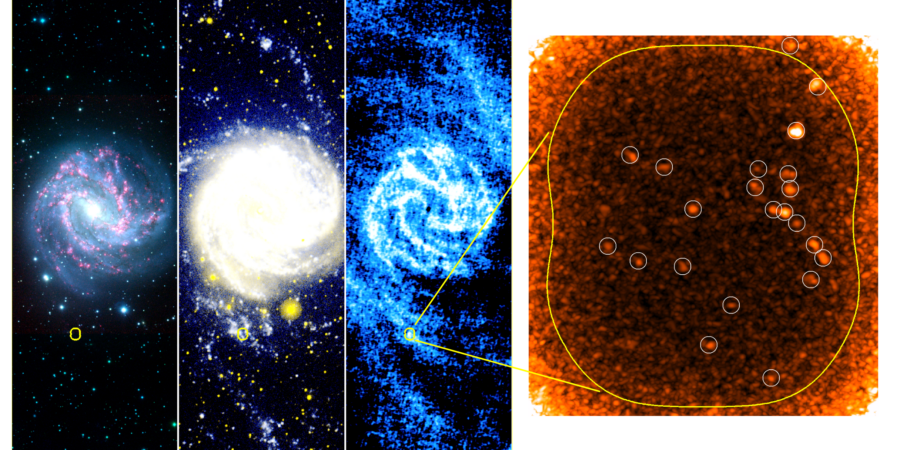
International research team led by Stony Brook Professor Jin Koda and including Samuel Boissier from LAM uncovers the Mystery of star formation at the edge of Galaxies
The mystery of star formation in galaxies continues to intrigue astronomers worldwide. Yet a key question remains just how and why and where do stars form in the Universe? A new discovery from an international team of astronomers
provides a significant clue to star formation.
The research team used the Atacama Large Millimeter/submillimeter Array (ALMA) and investigated the far edge of the spiral galaxy M83, at a distance of 15 million light years from earth. They uncovered 23 concentrations of a dense molecular gas called “molecular clouds,” which are evidence of the birthing region of stars.
Molecular clouds are a typical site for star formation in the inner parts of galaxies. When it comes to the far edges of many galaxies, scientists had yet to understand how and why stars form because they could not pinpoint their formation sites. Yet, a surprising number of very young stars are known to exist at the far edges of many galaxies. The discovery of these 23 molecular clouds appears different from their counterparts in the typical star-forming sites in
galaxies. The large bodies of these clouds were not visible like “normal” molecular clouds—only their star-forming dense cores, the “hearts” of the clouds, were observed. This new research finding opens the door to a better understanding of the process of star formation in the Universe in general.
Additionally, the molecular cloud discovery uncovered a key link to the large reservoir of the diffuse atomic gas within the clouds. Normally, the atomic gas condenses into dense molecular clouds, where even denser cores develop and form stars. This process of conversion from atomic to molecular gas occurs even at the galaxy edges, but the conversion turned out to be very inefficient.
Koda and colleagues presented their findings in the 243rd meeting of the American Astronomical Society (AAS) in New Orleans on January 8. The AAS presentation included a confirmation of the hypothesis presented in a 2022 paper, titled “First Detection of the Molecular Cloud Population in the Extended Ultraviolet Disk of M83,” published in The Astrophysical Journal , along with new findings by way of the Jansky Very Large Array (VLA) and Green Bank Telescope (GBT).
Samuel Boissier contributed to the discovery of star formation at galaxy edges 18 years ago by the NASA’s GALEX satellite in so-called XUV galaxies, such as M83 . “This type of star formation at galaxy edges have been a nagging mystery since their discovery” says Koda, lead researcher. “Astronomers are eager to understand how stars form, and our discovery provides a clue to star formation processes.” Koda and co-authors write that “these molecular clouds are likely the main drivers of the star formation activity in galaxy edges.” They further explain: “We hypothesized that these clouds share, on average, the same common structure (mass distribution) as molecular clouds in the Milky Way, such as Orion, and have star-forming dense cores embedded in thick layers of bulk molecular gas. However, their envelopes are invisible.”
The revelation of these molecular clouds uncovered a link to a large reservoir of diffuse atomic gas, another discovery by this research. Normally, atomic gas condenses into dense molecular clouds, within which even denser cores develop and form stars. This process is in operation even at galaxy edges, but the conversion of this atomic gas to molecular clouds was not evident, for reasons that are unresolved.
Koda and colleagues came to their conclusion by using data collected using several instruments including the Atacama Large Millimeter/submillimeter Array (ALMA), the Karl G. Jansky Very Large Array (VLA), and the Green Bank Telescope (GBT), as well as with the National Astronomical Observatory of Japan’s (NAOJ) Subaru Telescope and the NASA Galaxy Evolution Explorer (GALEX).
Amanda Lee, who was an undergraduate student on Koda’s research team at Stony Brook University, processed GBT & VLA data for these findings. Through this, she discovered the atomic gas reservoir at the galaxy edge.
“We still do not understand why this atomic gas does not efficiently become dense molecular clouds and form stars,” adds Lee, who is now pursuing her Ph.D. in astronomy at UMass Amherst. “As often is the case in astronomy, pursuing answers to one mystery can often lead to another. That’s why research in astronomy is exciting.”
The research that led to team’s findings was supported in part by National Science Foundation grant AST-20006600 and by NASA grant NNX14AF74G.




